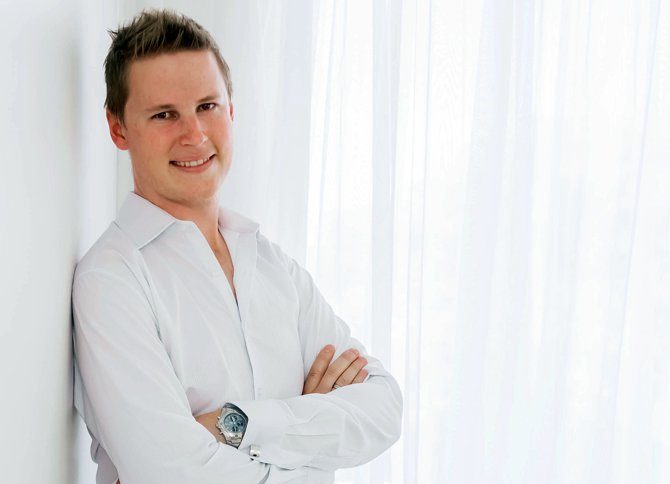24 Sep 2018
The ability to create complex 3D construction models in his head has proven an asset for a Christchurch hydraulic engineer who uses his dyslexia to his advantage.

Marc Jensen
Marc Jensen’s parents suspected he was dyslexic after he swallowed a poisonous seed during his childhood in Zimbabwe.
“I had a paralysed tongue and needed speech therapy and they realised I had to be taught differently.”
Officially diagnosed at around five years old, Marc benefited hugely from his mother, who is also dyslexic, teaching him after school.
“Because she knew how her brain worked, she started picking up early that both my brother and I were highly dyslexic, and my sister mildly. She would teach us through touch, smell and feel. She was an exceptional teacher.”
The hydraulic engineer at TM Consultants says most people discover how they learn once they reach university but he had the advantage of discovering his style early on.
“With dyslexia you see everything in 3D. If I hear the word ‘horse’ for example, I immediately see a detailed horse running through a field, whilst others see the text or have to consciously conjure the image.”
He says that while that’s easy to do for words that have an image associated with them, 60 percent of words do not.
“When I was studying in the 90s, I created in my mind scrolling 3D words, so instead of just viewing a word floating in space, I could see it moving and in 3D.”
Marc and his family moved to New Zealand in 2004 and he studied engineering at both the University of Canterbury and Christchurch Polytechnic. He found the polytechnic’s more practical, visual approach better suited to his learning style.
He approached problem solving in a visual way. For example, when faced with the question: "what is the deflection of a bridge surface and what stiffener can you use to strengthen it?" he'd mentally see a car moving over a bridge. He would model the forces coming out of the wheels and going into the supports of the bridge, then establish the different types of supports or reinforcing in his mind.
Marc says that despite the expectation at university to write screeds of notes, he would just listen and create detailed mental images.
“They say an image is worth a thousand words, but if you have a video that’s interactive – like 3D virtual reality goggles – you can look around anywhere in time and space and see exactly what’s happening.”
While coming up with a different solution was marked down at university, Marc says this approach has been very helpful in the construction industry.
“There’s no doubt about it, it’s a strength. Being able to create a 3D model in your mind is so much faster than you can process text. I’m able to spin the whole thing around and discover chinks in the armour."
“If people are struggling to come up with an answer, often they will ask me and I’ll give them an answer that’s not something they would have thought of, not in textbooks.”
For example, on one commercial development with substantial areas of glazing, he and colleagues reduced the typical insulation thicknesses and requirements for very high performing glazing, while fully complying with the Building Code.
“We then balanced the insulation throughout the development to better equalise the heating and cooling loads for the HVAC system. This saved our client expense and the reduction of insulation thicknesses had the additional effect of increasing the rentable floor area.”
Marc says in his role as a hydraulic engineer, when he gets a client calling with a problem such as a boggy site that needs a wastewater system, he goes on Google Earth and “I turn it into a 3D image in my mind”.
“I then take all the theoretical knowledge that I’ve got, such as interflow [water flowing between different layers of soil], different levels of treatment, and the different land application systems, and I can imagine how the entire site works together. I can then look at all the other services and easements and create a mental 3D model of where the effluent field needs to go.”
He says when designing duct work, he can place himself in the 3D model in his mind, move duct work around and analyse the vibration from the air unit coming through as airwaves and bouncing off different structures.
“Dyslexia is not a disability. The only time it ever holds you back is when you yourself are learning about it, but once you’ve figured that out and how to deal with it, you can be so much better than anyone thought you could be.”
Being able to create a 3D model in your mind is so much faster than you can process text.
About dyslexia
Dyslexia is usually a genetic, inherited condition affecting around one in 10 New Zealanders. It’s a processing difficulty that makes it harder for people to learn to read, write or do number work.
While dyslexia can present learning challenges, big-picture skills like problem solving, creativity, high-level conceptualisation and interconnected reasoning can be real strengths. People with dyslexia can often perceive the world from many perspectives with their unique visual-spatial thinking. This can be an advantage in fields such as engineering, the arts, design, leadership, entrepreneurship, sciences, business and technology.
Famous people with dyslexia include Sir Richard Branson, Whoopi Goldberg, Jamie Oliver, Orlando Bloom, Keira Knightly and Kiwi Academy Award winner Sir Richard Taylor KNZM.
World Dyslexia Awareness Day is 4 October.




